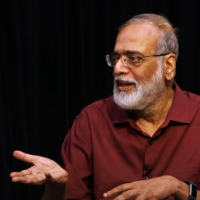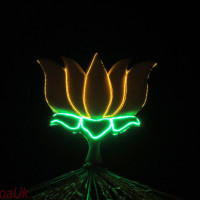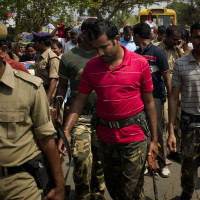Delhi Diaries The Dystopian Reality of India’s slide into Fascism
Topics
Regions
During my last days in Delhi the city is being draped in orange. The flags are flying from garlands criss-crossing busy market streets and narrow alleys, from almost all shops, from every lamppost along the slow-moving traffic lanes, from cars, from auto rickshaws, even from bicycles whose underdressed owners are shivering their way through the exceptionally cold winter days of late January. On the edge of the roads, vendors with handcarts sell the neon-coloured flags displaying the god Ram and an endless repetition of Jai Sri Ram, Jai Sri Ram, the background soundtrack to the temple inauguration that for weeks has seen large swathes of the population high on Hindu-nationalism.
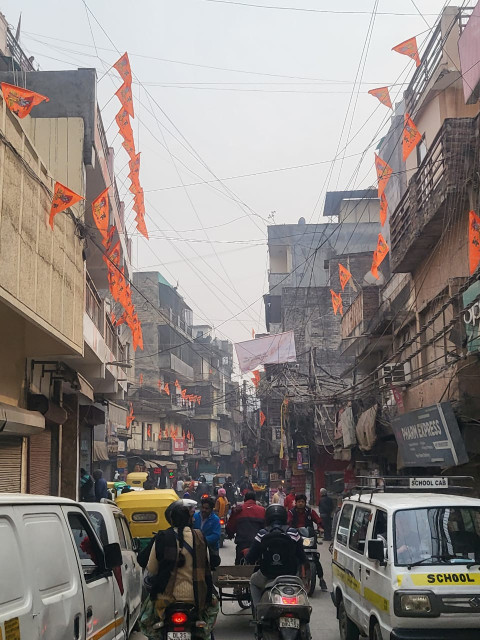
Private
The as yet unfinished Ram Mandir (temple of Ram) in Ayodhya is being built on the ruins of the Babri Masjid, a mosque that was destroyed by right wing fanatics in 1992. They claim that the mosque was built at the birthplace of the Hindu God Ram and accept the 2000 people that died in the ensuing violence – most of them Muslim – as a fair price to pay for clearing the area. After almost three decades of legal and political battles, the Indian Supreme Court ruled in 2019 that a temple should be constructed on the land. The judgment more than anything else reflected the decay of the Indian judiciary – the executive by then had long stopped even pretending it follows the secularism enshrined in the Indian Constitution. To quote Prime Minister Narendra Modi’s words from the temple inauguration ceremony: “Ram is the faith of India, Ram is the foundation of India. Ram is the idea of India, Ram is the law of India”. Defying Hindu tradition and angering more than a few senior priests, Modi chose to place statues of gods and perform the consecration rituals before the temple’s construction was completed, determined to milk the issue to the last drop in his bid for re-election in the general parliamentary elections in spring this year.
In the last general election in 2019, 37% of voters gave their vote to Modi’s party BJP, but with India’s first-past-the-post system this translated into a landslide victory of 56% of seats in parliament. With the state institutions firmly in his hand, the opposition bogged down with in-fighting or jailed, and any notion of an independent media gone for good, some polls predict Modi might score up to 10 percentage points more this time around.
*
“You shouldn’t have invested all that money into the house,” says Mahi* matter-of-factly, pointing to the air conditioner that’s proudly attached to the raw brick walls of the single room that forms Nadiya’s home. “The elections are coming, they will tear down your house and all the money will be lost. What’s the use?”
I have to blink, blink again, and stop for a moment. The year is 2024, the country India, and this is a normal Tuesday afternoon conversation between two of my friends. Welcome to Modi’s Amrit Kaal, the golden era that will supposedly see the country transform bottom-up.
Nadiya lives in a predominantly Muslim, informal and low-income neighbourhood not far from a busy metro station in South Delhi. There is a dispute as to whose land the houses are built upon. The state claims it belongs to the archaeological survey of India while the residents, some of whom have lived there for more than 30 years, who have seen children born, marry, and in turn give birth, claim it for themselves. In 1995, the government demolished the neighbourhood. The residents rebuilt their houses brick by brick, just to see them demolished again in 2012, and then once more in December 2022, with hundreds of families becoming homeless overnight each time. It was due to mere luck that Nadiya’s house was left standing this time around, and there is no way of knowing when the bulldozers will come back. While these demolition drives are not a unique feature of Modi’s government, they have intensified under his rule and are usually conducted in poor and/or Muslim neighbourhoods, often following rallies of the Hindu far right. They are indeed common enough to have earned themselves the nickname ‘bulldozer politics’.
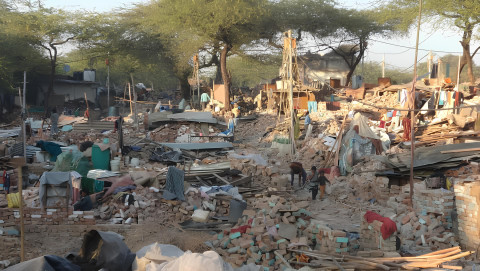
Private
Born into an impoverished family with 6 children, Nadiya has worked herself through government schools and universities to complete an MA in Hindi, has learned sewing, parlouring and other marketable skills in free courses along the way, and has amassed years of work experience as a teacher in underpaid NGO jobs. Now, having to look after her own son, she tutors children at her home, often teaching 30 pupils at once in a room that can’t be larger than 10 square metres. Working 8 hours a day, 6 days a week, she earns a few thousand rupees per month which she combines with the 12,000 rupees (roughly 130 Euros) her husband makes.
“Where would I go?” Nadiya asks when Mahi brings up the bulldozers again. “I can’t afford to move anywhere else. Plus, I grew up here, my whole family lives here, my son’s school is in walking distance. Tell me, where else should I go?”
*
Hindu nationalist ideology, or Hindutva, is built on Brahminism and propagates a type of Hinduism that is not representative of the incredibly diverse belief system practiced by Hindus across the Indian subcontinent. The BJP wants people to forget that Hinduism was never a unified religion but rather a collection of beliefs, rituals, and practices, the most unifying characteristic of which was for a long time that they neither fell under Buddhism, Islam, Jainism, Christianity nor any of the many other religions practiced in the region.
Hindutva followers stand against this diversity. They antagonise lower castes, tribes, Christians, the broader political Left, disapprove of sexual self-determination and women’s freedom, but most important of all, they hate Muslims. In the eyes of Hindutva supporters, Muslims should accept their place as second-class citizens, or, as a popular slang says, go to Pakistan.
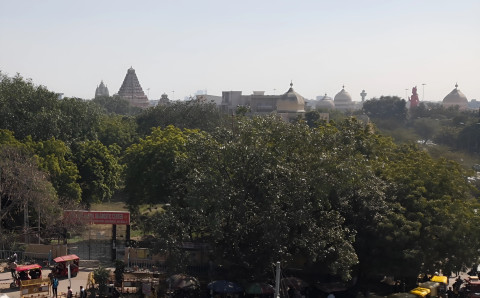
Jo
Attending an urban upper-middle class wedding, it is almost possible to forget all these politics. The discussions centre on who is wearing what, how the bride and groom are looking, and what desserts are being served. Then an older man starts a conversation with me, a wealthy upper caste Hindu with an impressive moustache that seems to grow longer the more the talk drags on. When I mention that I come from Germany, he enthusiastically starts telling me about a box of knives he got as a gift from a German friend a few years ago. “They’re so sharp,” he says in Hindi, chuckling, “they don’t just cut vegetables – they could even cut a katua.”
Later, I learn that katua is a derogatory slang for Muslim men who have been circumcised. I also learn that the older man alone bought 1000 orange flags to decorate his exclusively upper caste Hindu colony for the Ram Mandir inauguration.
*
Among the 2019/20 protesters against the Islamophobic Citizenship Amendment Act, a law which would see fast-track citizenship granted to applicants from all major religions except for Islam, and which could contribute to stripping Muslims of their citizenship, there was a white student with a sign that read “I’m from Germany, your grandchildren will be very pissed at you.”
I think about it often these days. So many things I see in India are achingly familiar from what I studied at school, and sometimes I want to scream out of sheer frustration at how glaringly obvious it is that history is repeating itself.
I think of Berlin's streets clad in swastika flags; of people boycotting Jewish shops the same way some Indians I know are now boycotting Muslim street vendors or maids; of laws banning kosher food or halal meat, restricting inter-religious marriage; of the prosecution of journalists, the imprisonment of political dissidents, the limitless surveillance of all citizens to make sure nobody will be able to escape; of the government forging and forcing a national uniformity on a territory that for the longest time was not one nation but the collection of various kingdoms in geographical proximity; of paramilitary ground forces like the SS marching in the street. Much like in Germany, the Rashtriya Swayamsevak Sangh (RSS), the Hindu nationalists’ volunteer paramilitary organisation with more than 5 million members, has been practicing for indoctrination and pogroms. The RSS has dedicated branches for women and children and runs India’s largest school network. The second chief of the 100-year old organisation openly admired Hitler and asserted that India should treat her minorities the same way the Nazis treated the Jews. Looking at the country now, it seems there isn’t a long way left to go for his wish to finally come true.
I think of the government renaming Muslim cities, tearing down Muslim architecture, erasing Muslim contributions to history; of them rewriting the country’s history. I think of the fake news filling newspapers, TV channels, schoolbooks, WhatsApp chats. The lies, the endless lies. ‘We do this for the country. For the greater good. We do this for you’.
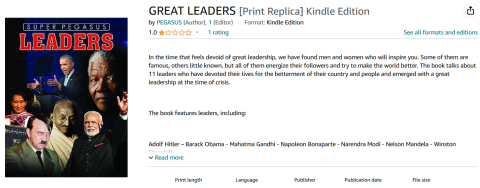
Screenshot
Is nobody else noticing? Does nobody else care? Nobody who matters, it seems, as countries and multinational companies keep doing business with India as if nothing is happening, exploiting its cheap wages, flexible environmental standards, and its government’s high demand for shiny new arms. It seems that nobody ever learns from history. (The Germans didn’t, for sure, or they wouldn’t be supporting Israel’s ongoing genocide in Palestine.)
Gaza has 2 million people, India maybe 200 million Muslims. Imagine: 100 times more spyware and arms to sell to a government that wants to get rid of them one way or another. In 2022 the Early Warning Project ranked India as the eighth most likely county in the world to see genocide. A recent poll found that almost half of all Indians said they were very much satisfied with Modi's work. Sometimes I have nightmares of what they may do to Nadiya if they get the chance.
*
I don't want to remember Delhi like that, draped in ugly neon orange, but the colour leaves an ugly aftertaste that doesn’t dissipate. Flying up and away through the layers of smog, I think of when I will return, and there is both yearning and fear in my heart.
Further reading
The Battle to Save India Has to Be Waged By Every Single One of Us by Arundhati Roy: https://thewire.in/rights/arundhati-roy-india-democracy-communalism
Ram ke Naam – In the Name of God: https://www.youtube.com/watch?v=UERGIoGgNBE
The Tragedy Of India’s Authoritarian Descent by Achin Vanaik: https://www.tni.org/en/article/the-tragedy-of-indias-authoritarian-descent
While We Watched, a documentary on journalist Ravish Kumar: https://www.whilewewatched.com/
Settled Habits, New Tricks: Casteist Policing Meets Big Tech in India: https://longreads.tni.org/stateofpower/settled-habits-new-tricks-casteist-policing-meets-big-tech-in-india
